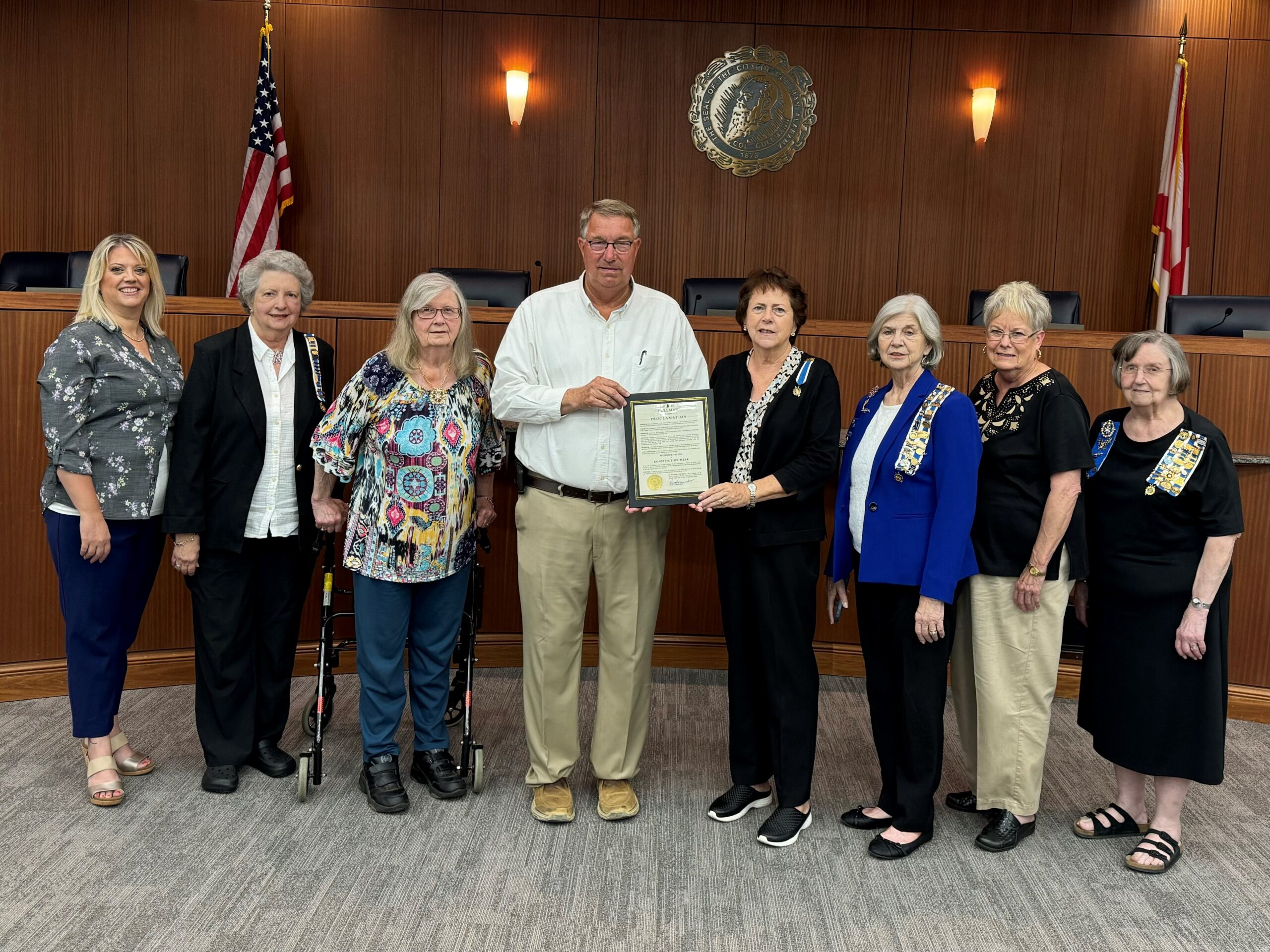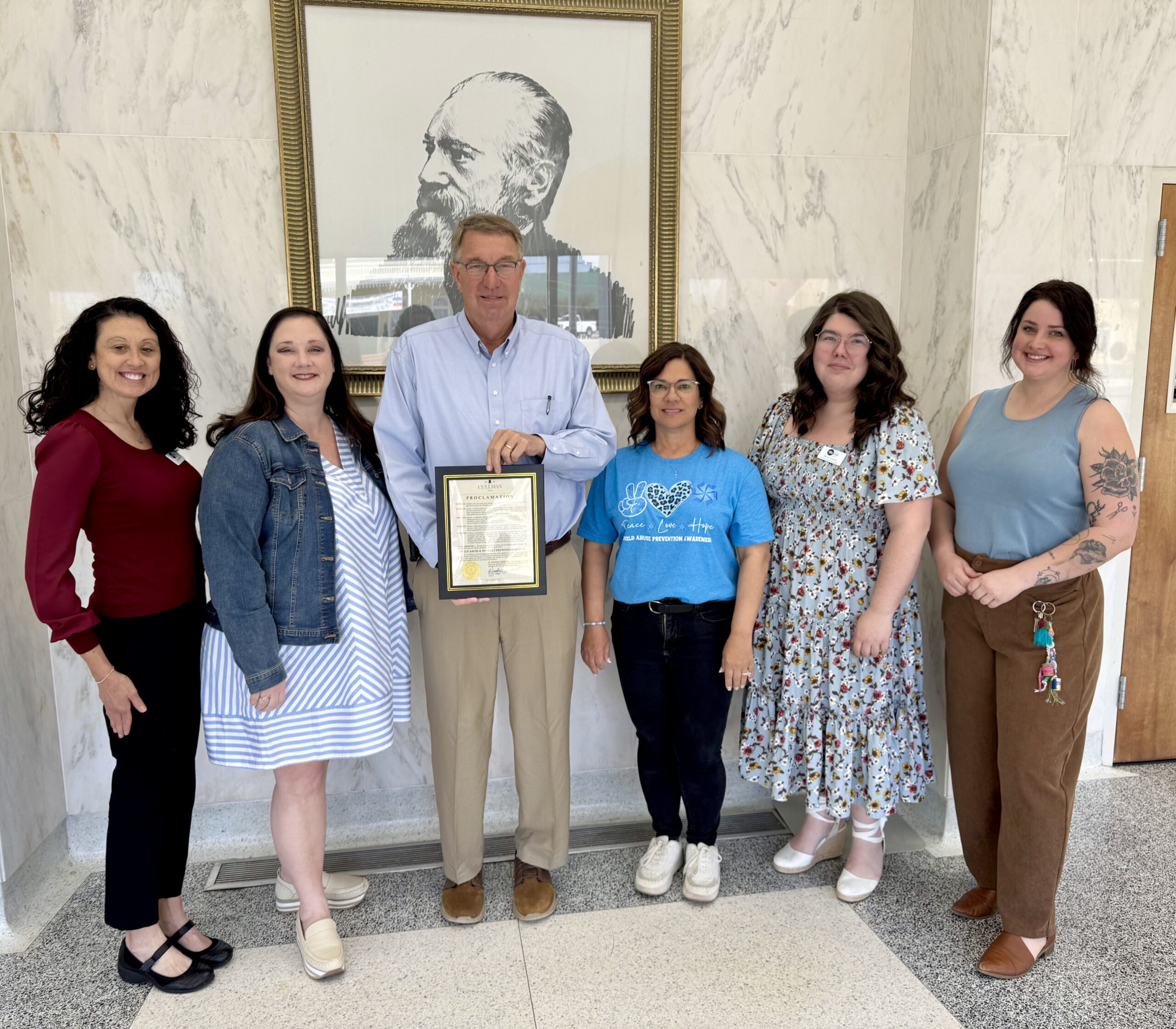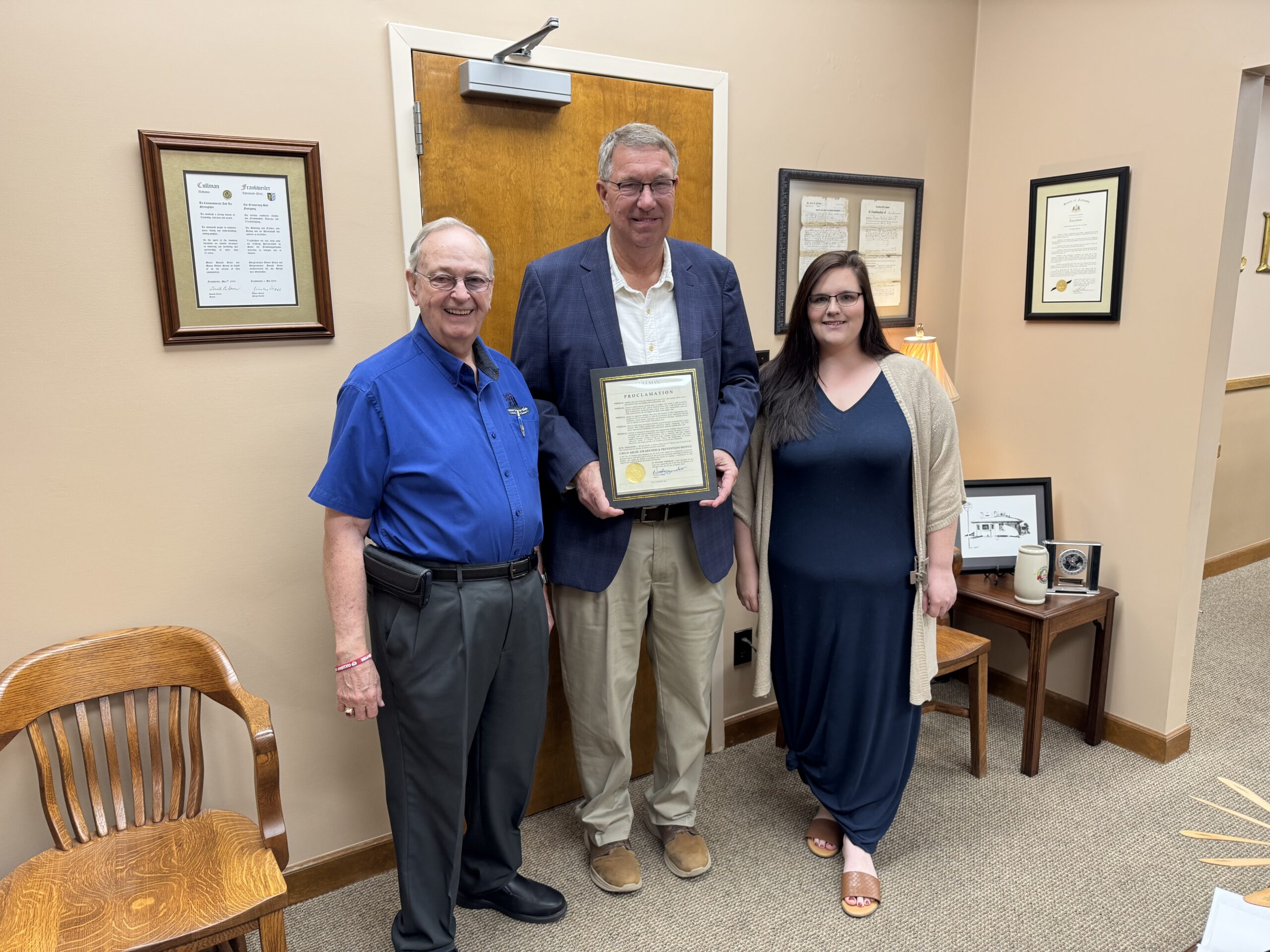The Constitution of the United States was made not merely for the generation that then existed, but for posterity – unlimited, undefined, endless, perpetual posterity.” – Henry Clay, 1850
On Tuesday, September 10, 2024, Mayor Woody Jacobs proclaimed the week of September 17-23, 2024, Constitution Week in the City of Cullman. On hand from the Daughters of the American Revolution (DAR) to accept the proclamation from Mayor Jacobs were Anita Winslow, Linda Kuykendall, Pat Kahler, Cathy Shallal, Rhonda Van Zandt, Peggy Harris, and Linda Schgier.
Created in 1787 and consisting of 4,400 words (4,543 including signatures), the U.S. Constitution is the shortest and longest-surviving written Constitution of any major government in the world. September 17, 2024, marked the 237th anniversary of the signing of this document.
In 1787, over the course of less than four months, a diverse group of men ranging in age from 26 to 81 devised a document that established our federal government with three equal branches of government and a system of checks and balances among those branches, divided power between the federal government and the states, and continues to protect the individual liberties of its citizens!
“I am a big proponent of people reading and understanding the U.S. Constitution,” said Mayor Woody Jacobs. “I am glad that the ladies of the DAR, along with other groups such as the Liberty Learning Foundation, work to promote understanding of the U.S. Constitution and to educate the public on the history of our great country.”
Constitution Week was started many years ago by the Daughters of the American Revolution (DAR). In 1955, the DAR petitioned Congress to set aside September 17-23 annually to be dedicated for the observance of Constitution Week. The resolution was adopted by U.S. Congress and signed into Public Law #915 on August 2, 1956, by President Dwight D. Eisenhower.
The purpose of Constitution Week is to emphasize citizens’ responsibilities for protecting and defending the Constitution to preserve it for posterity; to inform the people that the Constitution is the basis for America’s great heritage and the foundation for our way of life; and, to encourage the study of the historical events which led to the framing of the Constitution.
“I keep a copy of the U.S. Constitution in my office to remind me of the principles that this country was founded upon,” said Mayor Jacobs. “I encourage everyone to read the Constitution during Constitution Week so that we never forget its value.”
U.S. CONSTITUTION TIMELINE
- May 14, 1787: The Constitutional Convention assembled in Philadelphia at the State House – now Independence Hall. (The convention delegates, or deputies, were appointed by the legislatures of each state except Rhode Island, which sent no delegates. A total of 70 were appointed, but some could not attend or did not accept. In all, 55 delegates attended. Only 39 signed the Constitution.)
- May 25, 1787: A quorum of seven states was obtained. The delegates had actually gathered for the purpose of revising the existing Articles of Confederation. However, by mid-June 1787, the delegates had decided instead to completely redesign the government.
- July 16, 1787: There were several debates and heated arguments, but one of the fiercest debates was over congressional representation. Some delegates believed representation should be based on population and some delegates believed representation should be divided equally between the states. A compromise was finally reached on July 16, 1787, that gave each state one representative for every 30,000 people in the House of Representatives and two representatives, regardless of population, in the Senate.
- September 15, 1787: The Constitutional Convention adopts the Constitution.
- September 17, 1787: The final text of the Constitution is signed by the delegates. Thirty-eight of the 41 delegates who were present signed. George Reed signed for Delaware’s John Dickinson, who was absent, which brought the total number of signatures to 39.
- September 28, 1787: The Constitutional Congress formally submits the Constitution to the states for ratification. Ratification by 9 of the 13 states was needed to make the Constitution binding.
- December 1787: Five states – Delaware, Pennsylvania, New Jersey, Georgia, and Connecticut – ratified the Constitution quickly.
- February 1788: After a compromise assuring that amendments protecting basic political rights (later known as the Bill of Rights) would be proposed immediately, three more states – Massachusetts, Maryland, and South Carolina – ratified the Constitution.
- June 21, 1788: The ninth state to sign was New Hampshire, on June 21, 1788. The new government established by the U.S. Constitution legally began to function on March 4, 1789.
(Source: National Archives, archives.gov)
WHAT DOES THE CONSTITUTION SAY?
The U.S. Constitution contains a preamble, seven articles, and 27 ratified amendments.
- PREAMBLE: Communicates the intentions of the framers of the Constitution and the purpose of the Constitution. “We the People of the United States, in Order to form a more perfect Union, establish Justice, insure domestic Tranquility, provide for the common defense, promote the general Welfare, and secure the Blessings of Liberty to ourselves and our Posterity, do ordain and establish this Constitution for the United States of America.”
- ARTICLE I: Assigned the responsibility for making laws to the Legislative Branch (Congress). Establishes the House of Representatives and the Senate.
- ARTICLE II: Details the Executive Branch and the offices of the President and Vice-President.
- ARTICLE III: Establishes the Judicial Branch with the US Supreme Court as the federal court system’s highest court.
- ARTICLE IV: Outlines states’ powers in relationship to each other. States have the authority to create and enforce their own laws but must respect and help enforce the laws of other states.
- ARTICLE V: Explains the amendment process, which is different and more difficult than the process for making laws.
- ARTICLE VI: states that Federal law is higher than state and local laws, meaning that if a state law conflicts with a Federal law, Federal law takes precedence.
- ARTICLE VII: Describes the ratification process for the Constitution (nine states were required to enact the Constitution).
AMENDMENTS 1-10 (BILL OF RIGHTS):
- 1st Amendment: Freedom of the press, freedom of religion, freedom of assembly, and the right to petition the government.
- 2nd Amendment: Right to bear arms.
- 3rd Amendment: Protection against housing soldiers in civilian homes.
- 4th Amendment: Protection against unreasonable search and seizure. Protection against the issuing of warrants without probably cause.
- 5th Amendment: Protection against trial without indictment, double jeopardy, self-incrimination, and property seizure.
- 6th Amendment: Right to a speedy trial, to be informed of charges, to be confronted by witnesses, to call witnesses, and to legal counsel.
- 7th Amendment: Right to trial by jury.
- 8th Amendment: Protection against excessive bail, excessive fines, and cruel and unusual punishment.
- 9th Amendment: Rights granted in the Constitution shall not infringe on other rights.
- 10th Amendment: Powers not granted to the Federal Government in the Constitution belong to the states or to the people.
AMENDMENTS 11-27:
- 11th Amendment: Established that states can only be sued by their own citizens. States cannot be sued by people who live in other states or countries.
- 12th Amendment: Changed the way the President and Vice-President are elected. (Before this amendment, each member of the Electoral College cast a single vote, with the candidate receiving the largest number of votes becoming President and the candidate receiving the next highest number of votes becoming Vice-President. The 12th Amendment changed the process to the current system whereby one vote is cast for President and one for Vice-President.)
- 13th Amendment: Made slavery illegal in the U.S. Also made involuntary servitude illegal, except as punishment for a crime.
- 14th Amendment: Promised due process rights before taking away “life, liberty, or property” (Due Process Clause). Promises to give everyone “the equal protection of the laws” (the Equal Protection Clause). Establishes that all people born in the U.S. or naturalized here are citizens.
- 15th Amendment: Gave African-Americans and ex-slaves the right to vote. Ordered that no one should be unable to vote because of their race, skin color, or having been a slave in the past.
- 16th Amendment: Allowed Congress to start and collect an income tax without basing taxes on the states’ populations.
- 17th Amendment: Allowed the people to elect U.S. Senators by voting. (Prior to this amendment, U.S. Senators were chosen by state legislatures.)
- 18th Amendment (REPEALED): Made it illegal to make or sell alcohol in the U.S. (repealed December 5, 1933).
- 19th Amendment: Gave women the right to vote.
- 20th Amendment: Changed the date when the terms for President and Vice-President begins to January 20th and the terms for members of Congress to January 3rd.
- 21st Amendment: Repealed the 18th Amendment, making alcohol legal in the U.S. and allowing each state to decide whether to make alcohol illegal or make rules to control it.
- 22nd Amendment: Limited the number of times a person can be elected President.
- 23rd Amendment: Gave Washington, D.C., electors in the Electoral College.
- 24th Amendment: Made it illegal to keep someone from voting because they have not paid a poll tax or any other tax.
- 25th Amendment: Made rules about who would become President if the President became disabled or died, and who would become Vice-President if he had to take over for the President or died.
- 26th Amendment: Lowered the legal voting age to 18.
- 27th Amendment: Established that any pay raises for members of Congress must take effect after the next election.
(Source: National Archives, archives.gov)
To read the Constitution and other founding documents, or to find out more about the documents and the history of the United States, visit archives.gov or ask a DAR member.
To find out more about the Daughters of the American Revolution (DAR), visit dar.org.
Photo, L-R: Anita Winslow, Linda Kuykendall, Pat Kahler, Mayor Jacobs, Cathy Shallal, Rhonda Van Zandt, Peggy Harris, and Linda Schgier






